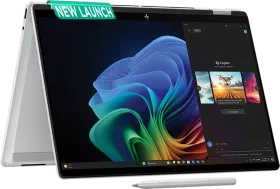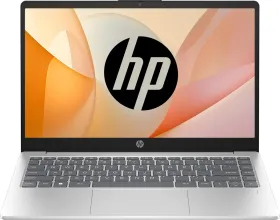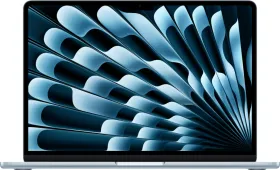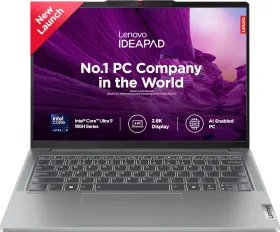Last year, ASUS knocked it out of the park with the Zenbook 14 powered by Intel’s Core Ultra Series 1, a powerful machine known for its lightweight design and a beautiful display. Fast forward to 2025, and we’ve got the revised Zenbook 14 (UX3405C), now rocking the Intel Core Ultra Series 2 processors.
It’s a familiar face with some fresh upgrades, aiming to keep its crown as a top-tier productivity laptop. Intel’s latest chips promise better efficiency, AI, and that all-day battery life we’ve come to crave, but how does it stack up in the real world? Let’s find out.
ASUS Zenbook 14 2025 (Core Ultra 5 225H) Price & Availability
The ASUS Zenbook 14 (UX3405C) starts at ₹1,12,990 for the 16 GB RAM + 1 TB SSD variant with Intel Core Ultra 225H. It comes in two classy shades: Foggy Silver and Ponder Blue (I tested the Silver one). You can grab it from the ASUS Store, Amazon, or major retailers across India.
ASUS Zenbook 14 2025 Review: Pros & Cons
Pros
- Super lightweight at 1.2 kg and ultra-thin at 14.9 mm
- Gorgeous 3K OLED touchscreen with 120 Hz refresh rate
- Premium all-aluminum build with a sleek look
- Fast charging via USB-C
- Good port selection, including Thunderbolt 4 and HDMI 2.1
- Comfortable, quiet keyboard with backlighting
- Responsive touchpad with multitouch gestures
- Strong productivity performance with Intel’s latest chip
Cons
- Touchscreen feels limited without a 360-degree hinge
- Glossy display picks up reflections outdoors
- Old-school brick charger feels dated
- The speakers could’ve been better
- Webcam needs improvement
ASUS Zenbook 14 2025 Review: Design and Build

The Zenbook 14 is a looker. At just 1.2 kg and 14.9 mm thick, this 14-inch compact beauty slips into my bag like it’s not even there. The all-aluminum chassis feels sturdy and high-end, with ASUS’s monogram logo etched cleanly on the lid. The 180-degree “ErgoLift hinge” is a nice touch—it props up the keyboard for better airflow and typing comfort, and it opens flat with one finger, which I love.
The finish is smooth and anodized, so it keeps away from fingerprints. Available in Foggy Silver and Ponder Blue, it’s got a minimalist vibe that screams professionalism. The cooling vents sit to the bottom and the left.
I/O

For a slim laptop, the Zenbook 14 packs a decent port lineup. On the right side, you’ve got two Thunderbolt 4 USB-C ports (40 Gbps, Power Delivery, and DisplayPort)—a bold choice to cluster them there, but it works.
There’s also a full-sized HDMI 2.1 port for 4K at 60 Hz and a headphone jack. There sits a lonely USB 3.2 Gen 1 Type-A port on the left. I’d have liked a USB-C on the left for charging flexibility, but it’s not a dealbreaker.
The bottom houses dual super-linear speakers, while the top bezel sports a Full HD IR webcam with a privacy shutter. Weight distribution feels spot-on, making it comfortable to use even on my lap and in bed.
Windows Hello: IR Recognition

The IR camera for Windows Hello is fast when it works, unlocking the laptop in a snap. It even wakes up automatically when I approach, which is also very good. It even works in low-light.
But it’s finicky—I often had to adjust my angle to get it to recognize me. A fingerprint scanner would’ve been a welcome alternative, especially since the touchscreen doesn’t fully justify the lack of biometric options.
Upgradability

Not much room to tinker here. The 32 GB of LPDDR5X RAM is soldered, so you’re locked in. Storage is a 1 TB PCIe 4.0 NVMe SSD, and while you can swap it for a 2 TB drive, there’s no second slot. It’s a trade-off for that thin chassis, but it’s worth noting.
ASUS Zenbook 14 2025 Review: Keyboard and Trackpad

The ErgoSense keyboard is a joy—1.4 mm key travel, subtle dish-shaped keys, and a quiet, responsive feel. It’s backlit with adjustable levels, and the ambient light sensor dims it automatically, which is handy.

The power button is positioned to the left of the Del key, which is both a good thing and a bad thing. Anyway, the arrow keys are all tiny here but hey, at least they are all the same size. The Copilot key is here, if you are wondering. And as I always do, I remapped it back to the Ctrl key.

The touchpad is smooth as butter, with a PVD anti-fingerprint coating that keeps it slick after hours of use. Multitouch gestures—like three-finger app switching—are spot-on, and the optional NumberPad 2.0 (you get 2 brightness levels) is a neat trick for number-crunching, though I rarely used it.
ASUS Zenbook 14 2025 Review: Display

The 14-inch 3K (2880 x 1800) ASUS Lumina OLED touchscreen is a stunner. With a 16:10 aspect ratio, 120 Hz refresh rate, and 100% DCI-P3 color gamut, it’s a feast for the eyes—deep blacks, vibrant colors, and 600 nits peak brightness in HDR. Scrolling is buttery smooth, and the extra vertical space is a boon for multitasking.
The glossy finish certainly adds a premium touch, but in bright outdoor settings, it becomes a major drawback, reflecting everything around it and making visibility a challenge. Indoors, however, it maintains a flawless look. That said, a matte option would have provided better usability across different environments.
As for the touchscreen, while it is responsive, its functionality is somewhat restricted by the 180-degree hinge. Without the flexibility of a full 360-degree rotation, it falls short of being a truly versatile tool. Thus, I didn’t find myself using the touchscreen very often.
ASUS Zenbook 14 2025 Review: Software

Running Windows 11 Home, the Zenbook 14 delivers a smooth experience, even when juggling 30+ tabs. Performance remains snappy, making it a solid choice for multitasking.
The MyASUS app adds even more functionality, serving as a central hub for battery monitoring, performance control, and other things such as the keyboard and trackpad settings. It’s intuitive and makes system management easy.
Connectivity is also solid. You get Wi-Fi 7 and while I haven’t been able to test that, the Wi-Fi on the Zenbook 14 has been pretty reliable. AI features like noise-canceling audio and camera enhancements are also there to improve your experience.
ASUS Zenbook 14 2025 Review: Performance

The Zenbook 14 we have is powered by the Intel Core Ultra 5-225H (Series 2), a 14-core processor equipped with a built-in NPU for AI and an Intel Arc GPU. Our variant has 32 GB of LPDDR5-7448 RAM and a 1 TB PCIe 4.0 SSD.
You can also configure the Zenbook 14 with up to Intel Core Ultra 9-285H and 32 GB LPDDR5X RAM + 1 TB of PCIe 4.0 SSD.
The Zenbook 14 delivers solid performance for productivity—whether it’s handling dozens of browser tabs, managing demanding workloads, or even light video editing. The integrated NPU is designed to enable low-latency AI tasks, though I didn’t push it with heavy generative workloads.
As for gaming, that’s not its primary focus. While the Arc GPU manages casual titles well, it falls short of delivering high-end gaming performance. Here’s how it performs in benchmarks and real-world gaming scenarios:
Synthetic Benchmarks
(All tests run plugged in)
| Benchmark Test | Scores |
| 3DMark Wildlife Extreme | Score: 4,187, FPS: 25.08 |
| 3DMark Time Spy | Overall: 2,840, Graphics: 2,610, CPU: 5,694 |
| 3DMark Storage Test | Score: 1,809 |
| 3DMark Solar Bay | Score: 9,962 |
| 3DMark Steel Nomad | Score: 621; FPS: 6.21 |
| 3DMark Wildlife Extreme Stress | Best Loop: 14,719, Worst Loop: 14,566, Frame Rate Stability: 99% |
| Geekbench 6 CPU | Single-Core: 2,617, Multi-Core: 12,834 |
| Geekbench 6 GPU | OpenCL: 25,405, Vulkan: 29,800 |
| Geekbench 6 AI | Single Precision: 2,288, Half Precision: 1,187, Quantized: 4,697 |
| CrystalDiskMark | Read Speed: 5,052 MB/s, Write Speed: 3,658 MB/s |
| Cinebench r23 | Single-Core: 1,644, Multi-Core: 11,184 |













As for the thermals, the Zenbook 14 does get usually hot at times and thus, the performance starts to drop a little. The fans are also almost always running but they’re not loud enough to bother you.
ASUS Zenbook 14 2025 Review: Battery Life and Charging

ASUS advertises over 18 hours of battery life, but in real-world use, that figure feels overly optimistic. In my testing, battery performance varied widely, ranging from 5 to 9 hours depending on workload. With light use—browsing, a few tabs, and working in Word—I averaged around 6 to 7 hours, which is decent but nowhere near the promised “all-day” endurance.
Charging, however, is a strong point. The 75Wh battery reaches 100% in about 1.5 hours with the included 65W USB-C adapter, making quick top-ups easy. That said, the traditional brick-style charger feels outdated—I would have much preferred a sleek, modern PD charger for added portability.
ASUS Zenbook 14 2025 Review: Speakers and Webcam

The dual “super-linear” speakers deliver clear audio with decent volume, boasting a 50% amplitude boost over standard setups. While they’re perfectly fine for calls and casual listening, they fall short when it comes to loudness and depth. Given the premium positioning of the Zenbook 14, the speakers could have been better.
On the webcam front, the Full HD IR camera with 3D noise reduction performs well in good lighting, delivering good video. The built-in privacy shutter is a welcome addition, adding a layer of security. However, low-light performance is just average, with noticeable grain and reduced clarity.
Review Verdict: Should You Buy the ASUS Zenbook 14 2025?
The 2025 Zenbook 14 builds on last year’s success with a better processor, battery life, Wi-Fi 7, and that great OLED display. It’s a premium compact laptop for productivity pros, with a design that’s hard to beat at 1.2 kg.
The ASUS Zenbook 14 2025 truly delivers a premium experience for the price. But the battery life inconsistencies and lack of a 360-degree hinge are some drawbacks. Still, at ₹1,12,990, it’s a solid investment if you value portability, screen quality, and a premium design.

Smartprix ⭐ Rating: 8.6/10
- Design and Build: 9/10
- Keyboard and Trackpad: 9/10
- Display: 9.5/10
- Performance: 7.5/10
- Battery Life and Charging: 8.2/10
- Software: 9/10
- Speakers and Webcam: 8/10
First reviewed in March 2025.


































